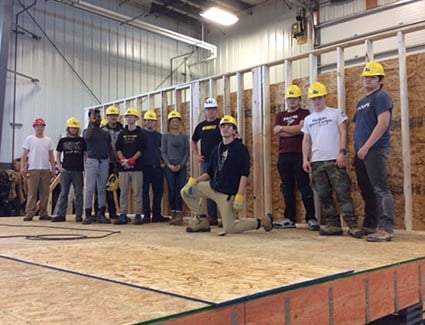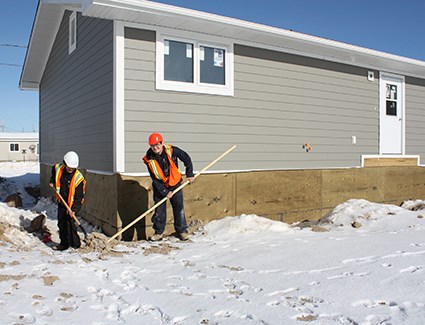A project constructed of lumber and nails has also built a partnership between students and schools that are hundreds of kilometres apart.
A home on the English River First Nation in the northern Saskatchewan community of Patuanak is the work of students in the High School Carpentry Apprenticeship Program (HCAP) at Mount Royal Collegiate and high school students at St. Louis School located on the first nation.
 Each semester, HCAP students build a home from start to finish with instruction and training from teacher Ross Johnson and the program's industry partners. From framing to finishing, students gain experience in all aspects of residential construction including drywall, electrical, plumbing, roofing, siding and cabinetry.
Each semester, HCAP students build a home from start to finish with instruction and training from teacher Ross Johnson and the program's industry partners. From framing to finishing, students gain experience in all aspects of residential construction including drywall, electrical, plumbing, roofing, siding and cabinetry.
But the house built by students during the first semester of the 2017-18 school year was unique. Instead of completing the entire project in the PotashCorp Learning Lab at Mount Royal, the three-bedroom house was loaded onto dollies and trucked more than 500 kilometres north to its new home at Patuanak. There students from that community had already helped prepare the site and pour the concrete footings. Their next task is to complete the interior finishing.
The project was a result of a chance meeting between St. Louis principal Geoff McFarlan and Brent Hills, a superintendent with Saskatoon Public Schools.
"Originally, the proposal was to build an eco-cabin on the reserve. The education band councillor challenged the administration to build a house to code," McFarlan said. "When I quipped about the challenge for the school to build a house Brent smiled and said 'I know someone that can help build you a house,' then pointed to Scott Farmer, the principal of Mount Royal Collegiate. We visited the school, we were very impressed with the HCAP program and proposed the plan to the band council."
The project was a perfect fit for HCAP as well. Without a contract to build a house for the fall term, students had been doing a variety of related projects including fencing, siding and shed builds for residents living in the collegiate's neighbourhood. Despite beginning the house project a month-and-a-half into the semester there was still time to get it to the drywall stage before it went to Patuanak.
"There is not a lot of opportunity for students (in Patuanak) to experience something like this so we thought it would be a really great partnership," said Karen Kurtenbach, HCAP's program facilitator, noting that the division of tasks outlined as part of the project meant it was a good fit for both groups of students.
In Patuanak, six Grade 10-12 students were chosen for the program based on their interest in a career in the construction industry. Their first test was to assist contractors in the community with selecting, surveying and preparing the site. From there, they helped build the forms for the cement footings, assisted in pouring the cement and built the pony walls that would support the house once it arrived from Saskatoon.
This spring, students will continue their work experience when they complete the plumbing, cabinets, walls and flooring installation. The goal is to have the project complete and ready for a family to move in by the end of the school year.
 English River First Nation purchased the materials for the project along with the necessary tools and safety gear required by the students. Cameco provided students with important training in WHMIS, fire extinguisher safety and fall protection before they began work.
English River First Nation purchased the materials for the project along with the necessary tools and safety gear required by the students. Cameco provided students with important training in WHMIS, fire extinguisher safety and fall protection before they began work.
"The students enjoyed the experience," McFarlan said. "They particularly enjoyed heading to the work site instead of the classroom. Staff noticed an improvement in behavior and attitude in the students that participated in the project and look forward to completing the finishing work in the spring. They have a real appreciation for the value of hard work and satisfaction of a job well done.
"The opportunity to work with community members was an enlightening experience and brings families closer together. Working with these role models and local successful tradespeople inspires them to pursue their dreams. The students were able to see an idea transform into reality that will be part of their community for the rest of their lives."
Working together has both HCAP and St. Louis School looking toward building on the partnership. There are discussions about building another house in the coming year, and Kurtenbach is hopeful that with one project complete they will be able to deepen the partnership and create a connection between the groups of students that wasn't possible during the first build. The Patuanak students were able to follow the project's progress via social media, she said, but that doesn't have the same impact as hands-on experience.
"It was a collaboration where their students got some experience and our students got some experience, but what I found missing was there wasn't a lot of communication between our students and their students," she said. "I like the idea of collaborating with other students, other schools and the community.
"What we are hoping for next time we do this — which is in talks for fall — that their students can come and maybe billet with us for a couple of weeks and start from the beginning. On the other end, once the house gets there, maybe our students could come and help with the finishing. That way they get to experience the whole thing."
McFarlan said the opportunity to work with HCAP has paid dividends for students, the school and the wider community.
"There is a shortage of quality housing on the reserve so there was a buzz around the idea. The students have had discussions about who will be living in the house and how 'cool' it is they helped make it happen," he said. "Cost-effective housing through this partnership will be self-sustaining in the community. It also provided jobs and an influx of capital to the local economy.
"Building a lasting partnership with Saskatoon Public and a proud, sovereign first nation is amazing. Students from both schools learn valuable life skills that prepare them for a career of gainful employment. A family now has a house they can call their home and will always remember that students from their community helped make it happen. The students from Mount Royal can be proud they contributed to solving a housing problem in a small, Indigenous community."